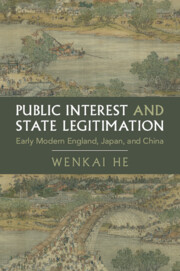Book contents
Introduction
Published online by Cambridge University Press: 17 November 2023
Summary
This chapter critically reviews the extant scholarship of state formation. It argues that the excessive attention to war and violence produces a confrontational interpretation of state–society relations and neglects the state's role in public goods provision vital to domestic governance. It outlines the main theme of the book, which is to bring state legitimation through public goods provision into the scholarship of state formation. It argues that a public interest-based discourse of state legitimation furnished a common normative platform for state and society to collaborate in various issues of domestic governance. This platform allowed state and society to complement each other's weakness in pursuit of good governance. It also provided a limited yet important space for political participation that could be accepted by the state authorities. Although this space was grounded in the conception of "passive rights" rather than "active rights" – that is, rights granted by the state rather than inalienable to the individual – it allowed for a growing degree and scale of political organization and activity and laid the basis for a rethinking of the role of such rights in state formation.
Keywords
Information
- Type
- Chapter
- Information
- Public Interest and State LegitimationEarly Modern England, Japan, and China, pp. 1 - 34Publisher: Cambridge University PressPrint publication year: 2023
